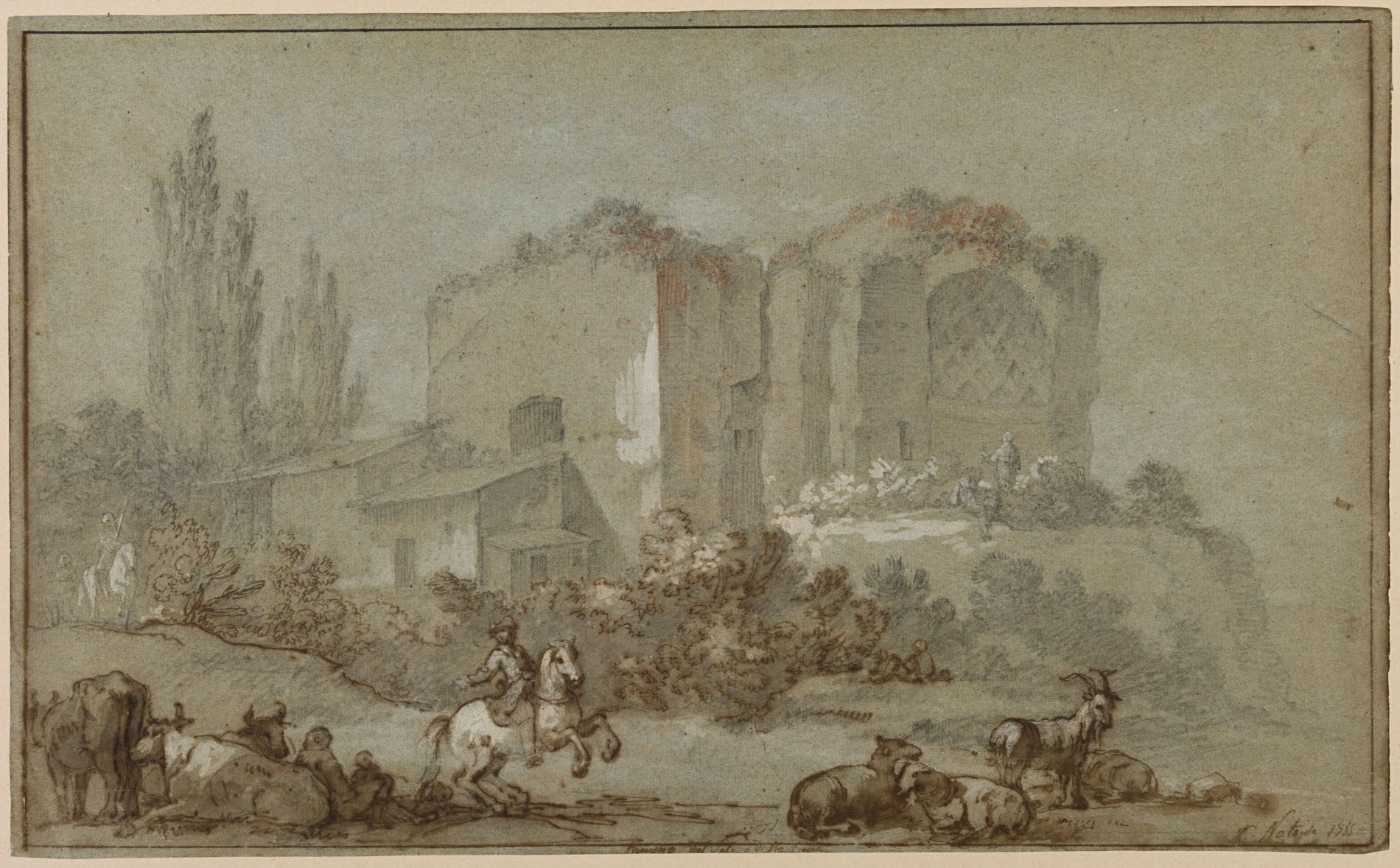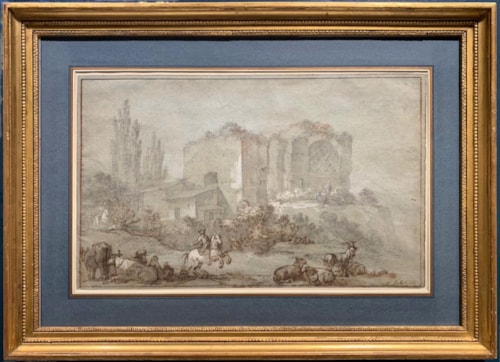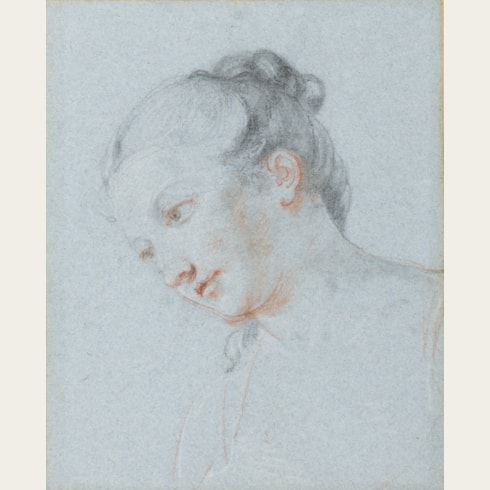Charles-Joseph NATOIRE
(Nîmes 1700 - Castel Gandolfo 1777)
Landscape with a Horseman and Animals before the Temple of Venus and Roma, Rome
Pen and brown ink and brown wash, with black chalk and touches of red chalk, heightened with white, with framing lines in brown ink, on blue paper.
Signed or inscribed and dated C. Natoire 1755 at the lower right.
Inscribed Tempio del Sole o della Luna at the lower centre.
284 x 466 mm. (11 1/8 x 18 3/8 in.)
Signed or inscribed and dated C. Natoire 1755 at the lower right.
Inscribed Tempio del Sole o della Luna at the lower centre.
284 x 466 mm. (11 1/8 x 18 3/8 in.)
Charles-Joseph Natoire’s extant oeuvre of around 125 Italian landscape drawings derive from the approximately 170 examples listed in the posthumous sale of the contents of his studio in 1778. The artist’s interest in landscape drawing was first manifested during his period of study at the French Academy in Rome between 1723 and 1728, which is the likely date of the present sheet, and was fully developed after his return to Italy as the Director of the Académie de France in the 1750s. His landscape drawings of this second Roman period - generally intended as finished works of art for sale, and for the most part dated between 1755 and 1766 - are characterized by picturesque compositions, often incorporating the monuments of Roman antiquity identified in inscriptions at the bottom of the sheet. Apart from views of Rome, Natoire also produced landscape drawings of views in the surrounding countryside; at Frascati, Tivoli, Caprarola, Valmontone, Albano, Nemi and elsewhere. His interest in achieving pictorial effects in his landscape drawings resulted in the use of a combination of pen and ink with brown or grey washes, along with black or red chalks and white heightening, together with the frequent use of blue or green paper. As in the present sheet, the artist often included figures or animals in the foreground of his compositions, creating a stage-like proscenium effect.
This drawing depicts the ruins of the huge ancient Roman Temple of Venus and Roma. Situated at the eastern end of the Forum, between the Basilica of Maxentius and the Colosseum, the Temple of Venus and Roma was one of the largest buildings in Ancient Rome. Built (and supposedly designed) by the Emperor Hadrian, on the site of the atrium of Nero’s grandiose palace known as the Domus Aurea, it was begun in AD 121 and dedicated in AD 135, before being completed in AD 141. The temple had two huge cellae, situated back-to-back and facing in opposite directions, with one dedicated to the goddess Roma and facing the Capitoline Hill, and the other, dedicated to Venus, oriented towards the Colosseum. Damaged by fire at the beginning of the 4th century and restored by the Emperor Maxentius, the building was largely destroyed by an earthquake in the early 9th century. Part of the cella of the temple dedicated to Roma was integrated into the late 9th century church of Santa Maria Nova, renamed San Francesca Romana in the 16th century, following an extensive program of rebuilding and renovation.
Standing to the southeast, with his back to the Colosseum, Natoire has here depicted the ruins of the cella of Venus, with its coffered apse dating from the restorations undertaken by Maxentius in AD 307. By the 18th century the structure was erroneously known as the Temple of the Sun and Moon, or Tempio delle Sole e Luna, hence the inscription on the present sheet. This fine landscape drawing has been dated by the Natoire scholars Susanna Caviglia-Brunel and François Wedrychowskito the artist’s first stay in Rome in the 1720s, despite the later dating at the lower right. The present sheet may be identified with a drawing depicting ‘les restes du Temple du Soleil & de la Lune’; one of a group of almost 170 landscape drawings by Natoire acquired en bloc, for a total of 7,030 livres, by the painter and art dealer Augustin Ménageot (c.1700-1784) at the posthumous sale of the contents of the artist’s studio in 1778.
More recently, the present sheet was part of the exceptional collection of architectural drawings, dating from the 16th to the 21st centuries, assembled by the Russian-German architect Sergei Tchoban (b.1962). Much of his collection is today housed in the private Museum for Architectural Drawing in Berlin, established by the Tchoban Foundation in 2013.
This drawing depicts the ruins of the huge ancient Roman Temple of Venus and Roma. Situated at the eastern end of the Forum, between the Basilica of Maxentius and the Colosseum, the Temple of Venus and Roma was one of the largest buildings in Ancient Rome. Built (and supposedly designed) by the Emperor Hadrian, on the site of the atrium of Nero’s grandiose palace known as the Domus Aurea, it was begun in AD 121 and dedicated in AD 135, before being completed in AD 141. The temple had two huge cellae, situated back-to-back and facing in opposite directions, with one dedicated to the goddess Roma and facing the Capitoline Hill, and the other, dedicated to Venus, oriented towards the Colosseum. Damaged by fire at the beginning of the 4th century and restored by the Emperor Maxentius, the building was largely destroyed by an earthquake in the early 9th century. Part of the cella of the temple dedicated to Roma was integrated into the late 9th century church of Santa Maria Nova, renamed San Francesca Romana in the 16th century, following an extensive program of rebuilding and renovation.
Standing to the southeast, with his back to the Colosseum, Natoire has here depicted the ruins of the cella of Venus, with its coffered apse dating from the restorations undertaken by Maxentius in AD 307. By the 18th century the structure was erroneously known as the Temple of the Sun and Moon, or Tempio delle Sole e Luna, hence the inscription on the present sheet. This fine landscape drawing has been dated by the Natoire scholars Susanna Caviglia-Brunel and François Wedrychowskito the artist’s first stay in Rome in the 1720s, despite the later dating at the lower right. The present sheet may be identified with a drawing depicting ‘les restes du Temple du Soleil & de la Lune’; one of a group of almost 170 landscape drawings by Natoire acquired en bloc, for a total of 7,030 livres, by the painter and art dealer Augustin Ménageot (c.1700-1784) at the posthumous sale of the contents of the artist’s studio in 1778.
More recently, the present sheet was part of the exceptional collection of architectural drawings, dating from the 16th to the 21st centuries, assembled by the Russian-German architect Sergei Tchoban (b.1962). Much of his collection is today housed in the private Museum for Architectural Drawing in Berlin, established by the Tchoban Foundation in 2013.
Charles-Joseph Natoire studied with his father before entering the Parisian studio of Louis Galloche at the age of sixteen, transferring after three years to the atelier of François Le Moyne. Winning the Prix de Rome in 1721, he arrived in Rome two years later, and lived as a pensionnaire at the Académie de France until 1728, also winning a first prize in a competition at the Accademia di San Luca. After a period of time spent travelling around northern Italy, Natoire returned to France in 1730, when he was admitted into the Académie Royale as an associate member, rising to full membership in 1734.
During the 1730s and 1740s he was much in demand as a painter, earning a number of significant Royal, public and private commissions. Among his most important works were a series of paintings for the château of La Chapelle-Godefroy in Champagne, executed between 1731 and 1738. He also joined François Boucher and Carle van Loo in the decoration of the Hôtel de Soubise, on which he worked at the end of the 1730s. Natoire received royal commissions for work at Fontainebleau, Versailles and Marly, as well as for designs for Beauvais and Gobelins tapestries. Appointed director of the Académie de France in Rome in 1751, he was to remain in Italy for the rest of his life. Between 1754 and 1756 he designed a fresco of The Apotheosis of Saint Louis for the vault of the nave of the French national church in Rome, San Luigi dei Francesi. Natoire painted relatively little during the 1760s, however, and much of his later Roman years were spent drawing. He encouraged the pensionnaires at the Académie to draw directly from nature, and himself produced a number of finished landscape drawings which were to have a particular influence on two of his young students, Jean-Honoré Fragonard and Hubert Robert.
During the 1730s and 1740s he was much in demand as a painter, earning a number of significant Royal, public and private commissions. Among his most important works were a series of paintings for the château of La Chapelle-Godefroy in Champagne, executed between 1731 and 1738. He also joined François Boucher and Carle van Loo in the decoration of the Hôtel de Soubise, on which he worked at the end of the 1730s. Natoire received royal commissions for work at Fontainebleau, Versailles and Marly, as well as for designs for Beauvais and Gobelins tapestries. Appointed director of the Académie de France in Rome in 1751, he was to remain in Italy for the rest of his life. Between 1754 and 1756 he designed a fresco of The Apotheosis of Saint Louis for the vault of the nave of the French national church in Rome, San Luigi dei Francesi. Natoire painted relatively little during the 1760s, however, and much of his later Roman years were spent drawing. He encouraged the pensionnaires at the Académie to draw directly from nature, and himself produced a number of finished landscape drawings which were to have a particular influence on two of his young students, Jean-Honoré Fragonard and Hubert Robert.
Provenance
Probably the posthumous vente Natoire, Paris, Hôtel d’Aligre, 14 December 1778 onwards, as part of lot 251 (‘Deux autres; l’une représente les restes du Temple du Soleil & de la Lune, l’autre faite sur le Tibre.’), sold for 7,030 livres to Augustin Ménageot, Paris
E. de Bruyn
His sale, Brussels, Galerie Giroux, 13-15 December 1956, lot 202
Private collection, Belgium
Anonymous sale, Versailles, Hôtel des Chevau-Légers, 20 June 1982, lot 66
Anonymous sale, Paris, Hôtel Drouot, 23 March 2007, lot 70
Sergei Tchoban, Berlin.
E. de Bruyn
His sale, Brussels, Galerie Giroux, 13-15 December 1956, lot 202
Private collection, Belgium
Anonymous sale, Versailles, Hôtel des Chevau-Légers, 20 June 1982, lot 66
Anonymous sale, Paris, Hôtel Drouot, 23 March 2007, lot 70
Sergei Tchoban, Berlin.
Literature
R. A. d’Hulst et al, Dessins du XVe au XVIIIe siècle dans les collections privées de Belgique, exhibition catalogue, Brussels, 1983, pp.188-189, no.84 (entry by Guy Grieten); Eva-Maria Barkhofen, ed., Architekturwelten / Architectural Worlds: Sergei Tchoban – Zeichner und Sammler / Draftsman and Collector, exhibition catalogue, Frankfurt, 2010, p.44, pl.44; Vladimir Sedov and Irina Sedova, ed., The Golden Age of Architectural Graphic Art: Drawings and Drafts from the Sergei Tchoban Collection, exhibition catalogue, Moscow, 2010, pp.58-59, no.8; Susanna Caviglia-Brunel, Charles-Joseph Natoire 1700-1777, Paris, 2012, p.180, no.D.33 (as location unknown, and dated c.1723-1728); Moscow, State Tretyakov Gallery, Tolko Italiya!: Arhitekturnaya grafika XVIII-XXI vekov., exhibition catalogue, 2014, p.72, no.11; François Wedrychowski, Charles-Joseph Natoire: Dessins de paysage, Poitiers, 2015, p.21, no.8 (where dated c.1723-1728).
Exhibition
Brussels, Société Générale de Banque, Dessins du XVe au XVIIIe siècle dans les collections privées de Belgique, 1983, no.84; Frankfurt am Main, Deutsches Architekturmuseum DAM, Architekturwelten.Sergei Tchoban – Zeichner und Sammler, 2010, no.44; Moscow, The Pushkin State Museum of Fine Arts, The Golden Age of Architectural Graphic Art: Drawings by European Masters of the 18th – 19th Centuries from the Sergei Tchoban Collection, 2010, no.8; Moscow, State Tretyakov Gallery, Tolko Italiya!: Arhitekturnaya grafika XVIII-XXI vekov. / Only Italy!: Architectural Graphic Art of the 18th-21st Centuries, 2014, no.11.






